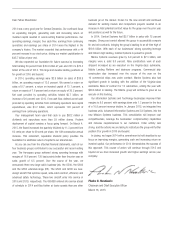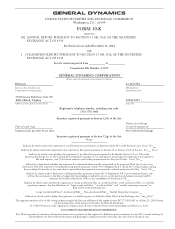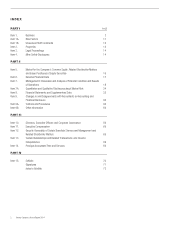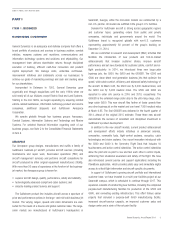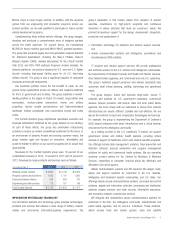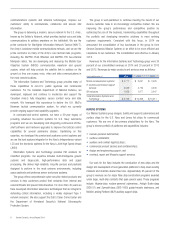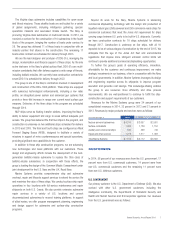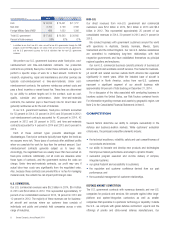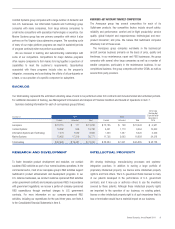General Dynamics 2014 Annual Report Download - page 12
Download and view the complete annual report
Please find page 12 of the 2014 General Dynamics annual report below. You can navigate through the pages in the report by either clicking on the pages listed below, or by using the keyword search tool below to find specific information within the annual report.
EMPLOYEES
On December 31, 2014, our subsidiaries had 99,500 employees,
approximately one-fifth of whom work under collective agreements with
various labor unions and worker representatives. Agreements covering
approximately 2 percent of total employees are due to expire in 2015.
Historically, we have negotiated successor labor agreements without
any significant disruption to operating activities.
RAW MATERIALS, SUPPLIERS AND
SEASONALITY
We depend on suppliers and subcontractors for raw materials,
components and subsystems. These supply networks can experience
price fluctuations and capacity constraints, which can put pressure on
our costs. Effective management and oversight of suppliers and
subcontractors is an important element of our successful performance.
We attempt to mitigate these risks with our suppliers by entering into
long-term agreements and leveraging company-wide agreements to
achieve economies of scale, and by negotiating flexible pricing terms in
our customer contracts. We have not experienced, and do not foresee,
significant difficulties in obtaining the materials, components or
supplies necessary for our business operations.
Our business is not seasonal in nature. The receipt of contract
awards, the availability of funding from the customer, the incurrence of
contract costs and unit deliveries are all factors that influence the
timing of our revenues. In the U.S., these factors are influenced by the
federal government’s budget cycle based on its October-to-September
fiscal year. Outside the U.S., work for many of our government
customers is weighted toward the end of the calendar year.
REGULATORY MATTERS
U.S. GOVERNMENT CONTRACTS
U.S. government contracts are subject to procurement laws and
regulations. The Federal Acquisition Regulation (FAR) and the Cost
Accounting Standards (CAS) govern the majority of our contracts. The
FAR mandates uniform policies and procedures for U.S. government
acquisitions and purchased services. Also, individual agencies can
have acquisition regulations that provide implementing language for the
FAR or that supplement the FAR. For example, the DoD implements the
FAR through the Defense Federal Acquisition Regulation Supplement
(DFARS). For all federal government entities, the FAR regulates the
phases of any product or service acquisition, including:
•acquisition planning,
•competition requirements,
•contractor qualifications,
•protection of source selection and vendor information, and
•acquisition procedures.
In addition, the FAR addresses the allowability of our costs, while the
CAS address how those costs should be allocated to contracts. The FAR
subjects us to audits and other government reviews covering issues such
as cost, performance and accounting practices relating to our contracts.
NON-U.S. REGULATORY
Our non-U.S. revenues are subject to the applicable foreign government
regulations and procurement policies and practices, as well as U.S.
policies and regulations. We are also subject to regulations governing
investments, exchange controls, repatriation of earnings and import-
export control.
BUSINESS-JET AIRCRAFT
The Aerospace group is subject to Federal Aviation Administration (FAA)
regulation in the U.S. and other similar aviation regulatory authorities
internationally, including the Civil Aviation Administration of Israel (CAAI),
the European Aviation Safety Agency (EASA) and the Civil Aviation
Administration of China (CAAC). For an aircraft to be manufactured and
sold, the model must receive a type certificate from the appropriate
aviation authority and each aircraft must receive a certificate of
airworthiness. Aircraft outfitting and completions also require approval by
the appropriate aviation authority, which often is accomplished through a
supplemental type certificate. Aviation authorities can require changes to
a specific aircraft or model type before granting approval. Maintenance
facilities and charter operations must be licensed by aviation authorities
as well.
ENVIRONMENTAL
We are subject to a variety of federal, state, local and foreign
environmental laws and regulations. These laws and regulations cover
the discharge, treatment, storage, disposal, investigation and
remediation of certain materials, substances and wastes. We are directly
or indirectly involved in environmental investigations or remediation at
some of our current and former facilities and at third-party sites that we
do not own but where we have been designated a Potentially
Responsible Party (PRP) by the U.S. Environmental Protection Agency or
a state environmental agency. As a PRP, we potentially are liable to the
government or third parties for the cost of remediating contamination. In
cases where we have been designated a PRP, generally we seek to
mitigate these environmental liabilities through available insurance
coverage and by pursuing appropriate cost-recovery actions. In the
unlikely event we are required to fully fund the remediation of a site, the
current statutory framework would allow us to pursue contributions from
10 General Dynamics Annual Report 2014


